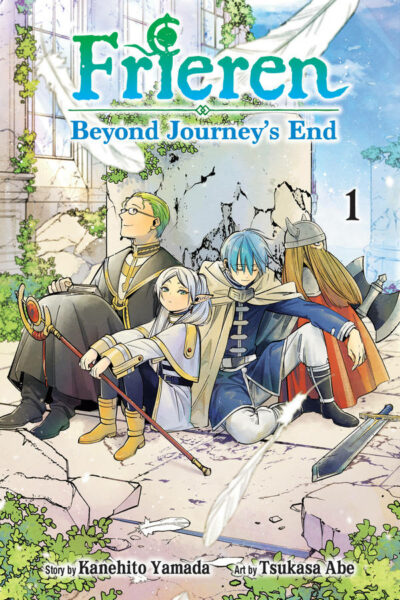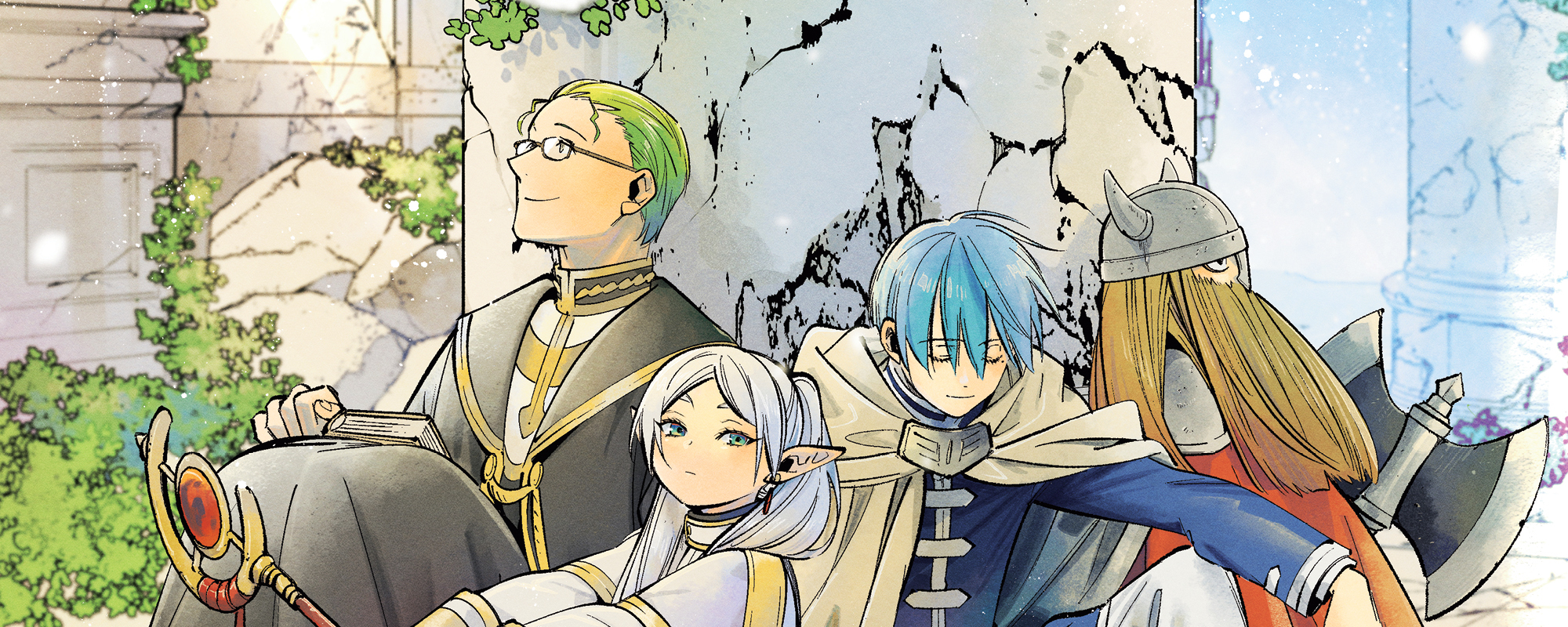The adventure has ended. Himmel the Hero and his party—Eisen the Warrior, Heiter the Priest and Frieren the Elven Mage—have defeated the Demon King. It’s at this point when the story should come to a close and wrap up how the adventurers have been affected by their journey. This is where the story was supposed to end.
But for an elf, “the end” feels as distant as the stars.
80 years have passed. Himmel the Hero has died. This should mean nothing. Humans die, and the party’s adventure was a scant 10 years, one-hundredth of an elf’s life. So why does Frieren shed tears at his funeral?
Frieren sets out to find the answer and fulfill the final wishes of her remaining party members—though it turns out said wishes include taking Eisen’s and Heiter’s wards along for the journey.

Frieren: Beyond Journey’s End
Story: Kanehito Yamada
Art: Tsukasa Abe
Publisher: Shogakukan, Viz Media
Genres: Drama, Fantasy, Adventure
Check our collection and reserve your copy today!
An Unexpected Journey
In the world of anime, manga and light novels, the last decade has seen a veritable deluge of fantasy deconstructions, satires, parodies and all-around playing with the established tropes of European-inspired fantasy. Rising of the Shield Hero replaces the eager and earnest hero we would normally get with an angry nihilist who has been chewed up and spat out by the fantasy world he was thrust into. Konosuba is an outright farce that milks JRPG logic for comedy. And So I’m a Spider, So What? sees our protagonist transported to a fantasy world only to take the form of a weak spider monster.
When there are already so many clever twists on well-worn fantasy tropes, it’s hard to stick out.
But the idea of an elf having to deal with the emotional fallout of outliving their shorter-lived companions? That’s the kind of premise that reaches out and grabs you.
Oftentimes, elves are supporting characters, either being a cool ranger like Legolas, an erudite and irritable mage that you’ve probably had in your D&D party, or the ethereally beautiful love interest like… well, like a ton of fantasy anime. The latter is a really common trope in Japanese media that draws from European fantasy, probably due to the influence of Record of Lodoss War and fan favorite character Deedlit. While it’s not the most recognizable name in European-inspired fantasy anime—that honor would easily go to the steampunk series Fullmetal Alchemist—the contribution of Lodoss War to the popularization of European fantasy in anime really can’t be overstated. As such, it’s common for our male, human hero to have a female love interest coming from some sort of fantasy race. So having a story that focuses on that potential love interest instead of the hero is really interesting! Usually, a character like Frieren would be relegated to the supporting cast, but here, she’s the star of the show.
New in Form, Traditional in Spirit
Frieren: Beyond Journey’s End is serialized by Weekly Shonen Sunday, a manga magazine I haven’t discussed on this blog nearly as much as its rival Weekly Shonen Jump. While Jump is known predominantly for battle manga, Sunday is best known in Japan as the home of mystery manga Detective Conan, published in North America under the name Case Closed. NA fans, however, will likely be more familiar with Komi Can’t Communicate or the many rom-coms of Rumiko Takahashi. So action manga isn’t Sunday’s bread and butter the way it is for Jump.
In this regard, Beyond Journey’s End fits snugly into Shonen Sunday’s lineup. There are action scenes, to be sure, but by the standards of action manga most fights are over in the blink of an eye—though these fights are greatly expanded in the animated adaptation.
This story is a drama, first and foremost. Its pacing is slow and relaxed, matching the pace with which Frieren approaches life. This story isn’t in a hurry to get anywhere. It has the same vibe as your average slice-of-life manga, but it’s hard to call it slice-of-life when said slices, more often than not, involve killing demons and dungeon diving for treasure. This story is an adventure, but it’s an adventure with the pacing of the epics of old that Tolkien drew from when he was writing The Hobbit and Lord of the Rings.
The overall mood of the series is very subdued. You’re not likely to see big, cartoonish overreactions from characters save for Stark, Eisen’s student and the cowardly warrior of Frieren’s new party. Characters seem to take even the darker elements of their fantasy world in stride, with Frieren and her apprentice Fern treating murderous demons like minor nuisances.
This consistent, relaxed tone makes for a unique experience where the emotionally heavy moments don’t hit the reader with a bang, but instead seep into your bones like the cold on a windless winter day. When you start to witness just how much Frieren and her original party meant to one another, it’s a dawning, bittersweet realization rather than a shocking twist. It’s the feeling of a memory slowly returning to the forefront of your mind, giving the reader a sensation similar to how Frieren must feel as she recalls how charming and kind her beloved Himmel could be. It evokes a bittersweet melancholy.
This series probably isn’t going to have you outright crying the way the likes of A Silent Voice or Violet Evergarden would, but rather leave you with a serene sadness—a feeling of mourning the tragedy, but marveling at the ephemeral beauty of what once was.
One of my classes was honored to have the great storyteller Anne Shimojima visit us, and she told us that what distinguishes traditional Japanese tales from Western fairytales is that Japanese tales are sad, but beautiful. Beyond Journey’s End honors and exemplifies this longstanding tradition.
On the Lighter Side
Now, one can’t sustain a manga for 13+ volumes on melancholy alone. Even stories with outright grim elements require some levity, lest the reader become bored by the lack of tonal shift. It’s these moments of levity where the characters are at their most charming.
 Frieren and Fern have an amusing dynamic in which the young human often has to take care of her ancient elven teacher—not because Frieren is too old to take care of herself, but because her impulsiveness and lack of time awareness can lead her to waste hours on trivial things, which is, most certainly, a mood.
Frieren and Fern have an amusing dynamic in which the young human often has to take care of her ancient elven teacher—not because Frieren is too old to take care of herself, but because her impulsiveness and lack of time awareness can lead her to waste hours on trivial things, which is, most certainly, a mood.
Fern may take responsibility for her impulsive master, but she has her childish side too. Fern gets grumpy and pouty at the slightest offense, something Stark often has to contend with. Stark, meanwhile, performs his duty as the team’s warrior exceedingly well but will whimper and whine about it the whole time.
And then we have Sein, our final companion, who offers a grounded, adult perspective whenever he’s not too busy complaining about the lack of hot older women on the team. Yes, Frieren points out that she’s technically older than Sein. No, it does not go well.
Side characters include Übel, a nonchalant killer who works her cutting magic based on vibes rather than academic study; Denken, a veteran mage who understands that just because you’re out of mana doesn’t mean you’re out of options; and Serie, the millennia-old master of Frieren’s magic teacher whose outlook on magic conflicts with Frieren’s. These colorful characters are a huge selling point for the series.
Final Thoughts
While sad but beautiful stories are certainly a cultural mainstay in Japan, Frieren: Beyond Journey’s End gives this tradition a new form. With the kind of premise that’s so simple, it makes you wonder how you never thought of it yourself. The mere concept is creative and compelling enough to grab your attention. Not content to rest on an interesting premise, Kanehito Yamada and Tsukasa Abe work together to craft a story that expertly blends humor and drama. There aren’t a lot of manga quite like this one, so I highly recommend checking it out.

